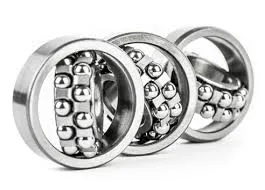
Dec . 19, 2024 01:39 Back to list
Dimensions and Specifications for 6308 Bearing Size Information and Applications
Understanding the 6308 Bearing Size, Features, and Applications
Bearings are fundamental components in machinery and equipment, enabling smooth motion and supporting loads. Among the various types of bearings available, the 6308 bearing series stands out due to its versatility and robust performance. This article delves into the specifics of the 6308 bearing size, its key features, applications, and factors influencing its choice in industrial and commercial settings.
Size Specifications
The 6308 bearing is categorized as a deep groove ball bearing, designed to handle both radial and axial loads. Its size specifications are critical for compatibility with various machinery. A standard 6308 bearing typically has the following dimensions
- Inner Diameter (ID) 40 mm - Outer Diameter (OD) 90 mm - Width (B) 23 mm
These dimensions position the 6308 bearing as a medium-sized bearing, widely utilized in different applications where moderate loads are present.
Key Features
One of the most significant features of the 6308 bearing is its deep groove design. This design allows it to accommodate axial loads in both directions, making it suitable for a wide range of applications that experience thrust and radial loads simultaneously. Other notable features include
1. Sealing Options The 6308 bearing is available in various sealing configurations, such as rubber seals (2RS), metal shields (ZZ), or open types. These adaptations are essential for different operating environments, helping to keep contaminants out and retain lubrication inside.
2. Material Composition Most 6308 bearings are made from high-quality steel, with variations including stainless steel for corrosion resistance. The material choice affects durability and performance under different operating conditions.
3. Cage Design Typically constructed from pressed steel or polyamide, the bearing cage helps to maintain proper spacing between the balls, minimizing friction and wear.
4. Load Capacity The 6308 bearing's design allows it to handle substantial loads relative to its size. Its dynamic load rating is approximately 18.5 kN, while the static load rating reaches around 10.5 kN, making it reliable for standard applications.
Applications
6308 bearing size

The versatility of the 6308 bearing allows for its usage in a myriad of applications across various industries. Some common applications include
- Electric Motors The 6308 bearing is frequently used in electric motors, where efficient rotation is critical for optimal performance. Its ability to handle both radial and axial loads enhances motor reliability.
- Automotive Industry This bearing can be found in numerous automotive components, including wheel hubs and transmissions, providing smooth operation and reducing the wear and tear on moving parts.
- Home Appliances Countless household appliances, such as washing machines and refrigerators, utilize 6308 bearings for their durability and ability to minimize friction, contributing to better energy efficiency.
- Industrial Equipment The 6308 bearing is prevalent in various types of machinery, such as conveyor systems, pumps, and fans, where consistent rotation and reliability are paramount.
Factors Influencing Selection
When selecting a 6308 bearing for a specific application, several factors must be considered
1. Load Type Understand the nature of the loads—whether they are primarily radial, axial, or both—to ensure proper bearing selection.
2. Speed Requirements The operating speed can influence bearing performance. Choose a bearing optimized for the expected rotational speeds to avoid premature failure.
3. Operating Environment Assess factors such as temperature, exposure to moisture, and contamination. The right sealing and material options can enhance the bearing’s life under challenging conditions.
4. Replacement vs. New Installation Consider whether the bearing is a replacement for an existing component or part of a new design. This influences the choice of tolerances and fit.
Conclusion
The 6308 bearing's size, features, and robustness make it an indispensable element in various applications. By understanding its specifications and adapting to specific operational needs, engineers and mechanics can ensure optimal performance and longevity in their machinery. With the right choice of bearing, efficiency, reliability, and productivity can be significantly enhanced in both industrial and commercial settings.
Latest news
-
Premium Deep Groove Ball Bearings | High Speed & Reliability
NewsAug.29,2025
-
Durable Scaffolding Clamps - Secure & Reliable Tube Connectors
NewsAug.28,2025
-
Common Failures in Thrust Ball Bearings and Solutions
NewsAug.22,2025
-
How Tapered Roller Bearings Can Take Shock Loads
NewsAug.22,2025
-
Angular Bearings in High-Precision Spindles
NewsAug.22,2025
-
The Impact of Misalignment on Cylindrical Roller Bearing Performance
NewsAug.22,2025
